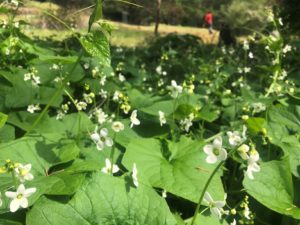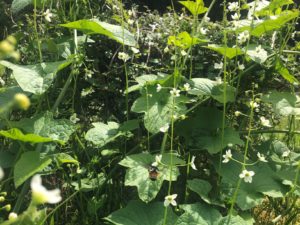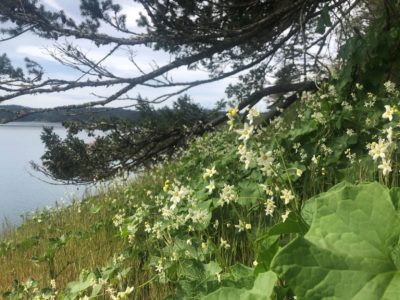– Kayla Seaforth, Orcas Field Assistant
During spring hikes on Turtleback Mountain Preserve many visitors react with concern over a vine that seemingly carpets the Garry Oak Savannah. During my three years as a steward of this preserve, one of the most frequent questions I get in the early summer is, “What is that invasive vine all over the mountain?” 
I’m here to set the record straight on the aggressive but short-lived vegetation associated with Oregon manroot, wild cucumber, or Marah oregana. This plant is native to the open prairies and lowland river valleys of our region; its range extends from coastal British Columbia south to California (USDA). Manroot vines emerge in late winter to early spring from woody tubers that can weigh hundreds of pounds. I first saw a manroot tuber when grubbing blackberry crowns on the slopes of Turtleback Mountain and was utterly perplexed by the waterlogged woody mass that I uncovered nearly a foot below the soil’s surface. It wasn’t until I saw the vine shoots emerging from one of these tubers and checked in with some more botanically inclined friends that I put it together: this was the source of those vines!
While it is true that manroot covers and shades a lot of ground in a very short period (some sources say that it may grow several inches in a day) the vines die back as the summer weather sets in. Manroot produces many small white flowers that are important early season nectar sources for local pollinators,  which later give way to spikey green fruits that resemble small, round cucumbers. These fruits are highly bitter (the genus name Marah literally translates to “bitter” in Hebrew), which might keep herbivores at bay. While little scientific data exists about the specific effects of manroot on prairie ecosystems, it may increase soil moisture retention through shading and the high water content of its tubers. When the vines wither after several weeks, they make way for the rolling blooms of other native species throughout the summer.
which later give way to spikey green fruits that resemble small, round cucumbers. These fruits are highly bitter (the genus name Marah literally translates to “bitter” in Hebrew), which might keep herbivores at bay. While little scientific data exists about the specific effects of manroot on prairie ecosystems, it may increase soil moisture retention through shading and the high water content of its tubers. When the vines wither after several weeks, they make way for the rolling blooms of other native species throughout the summer.
In some cases, Land Bank staff cut back manroot vines to give a competitive advantage to recently planted native wildflowers and trees, but this is done selectively. While it may be tempting to remove vines as you hike through the preserve, please leave this task to staff and authorized volunteers. I hope that armed with this knowledge, Marah oregana stirs feelings of admiration rather than horror as you walk the trails of Turtleback this spring.


